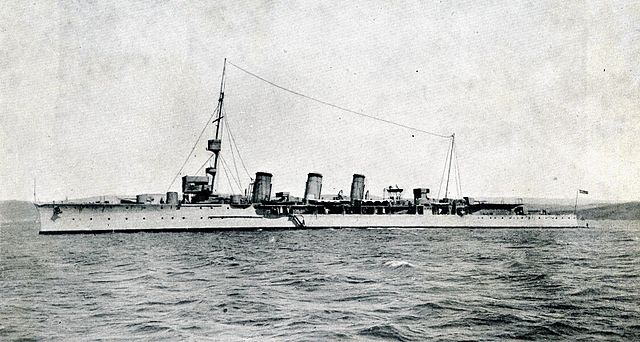Top Qs
Timeline
Chat
Perspective
Blas de Lezo-class cruiser
Spanish cruiser class From Wikipedia, the free encyclopedia
Remove ads
The Blas de Lezo-class cruisers were a group of two cruisers, built for the Spanish Navy in the 1920s. The ships were ordered in 1915 but construction proceeded slowly due to material shortages during World War I. The ships were built by Sociedad Española de Construcción Naval in Ferrol and showed considerable British design influence, resembling contemporary British C-class cruisers.
This article includes a list of general references, but it lacks sufficient corresponding inline citations. (January 2013) |
Remove ads
Characteristics
Summarize
Perspective
The Blas de Lezo class ships were ordered as "fast cruisers" inspired by the design of the British C-class light cruisers.[1] They were slower than the C-class, however, which in service proved to be their main limitation as combat ships, and they were reclassified as light cruisers as a result.[1]
The ships were 134.11 metres (440 ft 0 in) long between perpendiculars and 140.82 metres (462 ft 0 in) long overall. They had a beam of 14.02 metres (46 ft 0 in), a maximum draft of 5.6 metres (18 ft 4 in), and a height of 7.72 metres (25 ft 4 in). Their normal displacement was 4,780 tons, and they displaced 6,045 tons at full load.[1]
The ships were armed with six Vickers 152-millimetre (6 in) guns in single mounts, two forward, two aft, one on either side amidships, as well as four 47-millimetre (1.9 in) anti-aircraft guns located along the sides between the funnels. In 1930, twelve 533-millimetre (21 in) torpedo tubes of in four triple mounts were installed.[1]
The propulsion system consisted of four sets of Parsons turbines, six coal-fired Yarrow boilers, six oil-fired Yarrow boilers, which generated 43,000 horsepower (32,065 kW) and drove four propellers. The ships had a maximum speed of 29 knots (54 km/h; 33 mph). The fuel capacity was 730 tons of oil and 800 tons of coal, giving the ships a range of 5,000 nautical miles (9,300 km; 5,800 mi) at an economical cruising speed of 13 knots (24 km/h; 15 mph).[1]
The ships were armored, with 50 to 75 millimetres (2.0 to 3.0 in) of belt armor, 25 millimetres (0.98 in) of deck armor,[1] and a conning tower with 152 millimetres (6 in) of armor. Each ship had a crew of 320 men.[1]
Remove ads
Naming
Originally, the lead ship of the class was laid down with the name Blas de Lezo, thus giving the class as a whole this name, while the second ship received the name Méndez Núñez. However, by an order of May 1924, the ships swapped names so that the first ship, commissioned in 1924, could bear the name Méndez Núñez to honor the centenary of the birth of Contralmirante (Counter Admiral) Casto Méndez Núñez that year. Thus, the ship laid down in 1915 as Blas de Lezo was commissioned as Méndez Núñez in 1924, while the ship laid down in 1920 as Méndez Núñez was commissioned as Blas de Lezo in 1925.[1]
Remove ads
Ships
Summarize
Perspective
Blas de Lezo


Blas de Lezo was named after Admiral Blas de Lezo. In early 1926, she supported the transatlantic flight from Spain to Buenos Aires, Argentina, of a four-man Spanish Air Force crew led by pilot Major Ramón Franco – the brother of future Spanish caudillo Francisco Franco – and including copilot/navigator Captain Julio Ruiz de Alda Miqueleiz in the Dornier Do J Wal ("Whale") flying boat Plus Ultra ("Farther Still"), carrying spares and other equipment for the flight.[2] She struck a rock near Cape Finisterre in 1932 and sank in deep water.
Méndez Núñez


Méndez Núñez was named after Admiral Casto Méndez Núñez. She was based in Equatorial Guinea at the start of the Spanish Civil War and she returned home to fight for the Spanish Republican Navy. In 1939, following the Cartagena Uprising, she was interned in Bizerte and seized by the French authorities. She was later handed over to Francoist Spain.
Méndez Núñez was reconstructed into an anti-aircraft cruiser in 1944, rearmed with eight 120-millimetre (4.7 in) Vickers anti-aircraft guns in single mounts, eight 37 mm guns of German origin in four twin mounts, and eight 20mm light anti-aircraft guns of German origin in two quadruple mounts. The superstructure was completely rebuilt and fitted with modern fire-control equipment. Two triple banks of torpedo tubes were retained. Méndez Núñez served until 1963.
References
Bibliography
External links
Wikiwand - on
Seamless Wikipedia browsing. On steroids.
Remove ads

